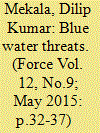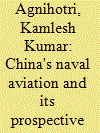| Srl | Item |
| 1 |
ID:
137852


|
|
|
|
|
| Summary/Abstract |
In the modern day naval warfare, undersea threats pose major challenges for any navy’s blue water aspirations. The underwater threats can be at harbour as well as on high seas. At a harbour, the major threats are in the form of terrorist attacks using divers for boarding the vessels with explosives or to attach explosives to a vessel’s hull; mines at strategic locations which can be deployed using divers or remotely operated vehicles (ROVs); using underwater vehicles laden with explosives to collide with ships. As far as high seas are concerned, the threats are usually known/well studied and include underwater offensives which can be launched from any submarine, surface, or air platforms. In order to be a dominant force in the seas, the navies must be prepared for any eventuality, both at harbour and high seas.
|
|
|
|
|
|
|
|
|
|
|
|
|
|
|
|
| 2 |
ID:
102856


|
|
|
|
|
| Publication |
2011.
|
| Summary/Abstract |
The PLA Navy's aviation branch, officially known as the PLA Navy Air Force (PLAN AF), comprises 25,000 personnel and more than 800 aircraft. It provides the PLA Navy with its own air capability independent of the PLA Air Force. But the Force remains largely land-based. However, the much speculated upon aircraft carrier program will impart a new dimension to the Chinese naval aviation. With the current level of national technological capability and available maritime infrastructure, the PLA Navy will, at best, be able to project power with its carriers within the South and East China Sea only, in the 2020 timeframe. It will find it increasingly hard to project power-using aircraft carriers in the Indian Ocean Region without full-fledged military bases to support logistics and ship and aircraft maintenance/repairs. Thus the credible Chinese power projection capability in the Indian Ocean still appears to be at least two decades away. But the international community must take due cognizance of this inevitability now and commence preparations to face this forthcoming challenge.
|
|
|
|
|
|
|
|
|
|
|
|
|
|
|
|